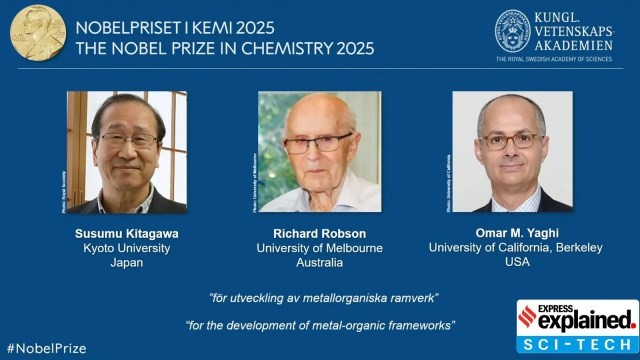Nobel Prize in Chemistry 2025

- 11 Oct 2025
In News:
The 2025 Nobel Prize in Chemistry has been awarded to Susumu Kitagawa (Japan), Richard Robson (Australia), and Omar Yaghi (Jordan–USA) for their pioneering work in developing Metal–Organic Frameworks (MOFs) — a novel class of crystalline materials with exceptional porosity and tunable chemical properties. Their innovation has transformed the field of materials chemistry, enabling new solutions for energy, environment, and sustainability.
About the Nobel Prize in Chemistry
Instituted under the 1895 will of Alfred Nobel, the Nobel Prize in Chemistry honours individuals whose discoveries have profoundly advanced the chemical sciences and benefitted humanity. The 2025 award acknowledges a transformative leap in reticular chemistry — the design and synthesis of porous networks using metal ions and organic linkers.
Genesis of Metal–Organic Frameworks (MOFs)
In most materials, atoms are tightly packed, leaving little internal space. The Nobel laureates devised a way to link metal atoms with organic molecules in an open, lattice-like structure that leaves large, orderly cavities — creating materials capable of trapping, storing, or releasing other molecules with precision.
- Richard Robson, in the 1970s at the University of Melbourne, first envisioned connecting atoms through molecular linkers to create spacious molecular architectures.
- Susumu Kitagawa in the 1990s demonstrated that such frameworks could be flexible, “breathing” materials capable of absorbing and releasing gases.
- Omar Yaghi, from the 2000s onwards, stabilised these frameworks and founded reticular chemistry, systematically designing MOFs for targeted purposes such as carbon capture, water harvesting, and gas storage.
What are MOFs?
Metal–Organic Frameworks (MOFs) are hybrid crystalline materials formed by coordinating metal ions or clusters (e.g., copper, zinc, aluminium) with organic ligands to produce rigid, porous 3D networks.
These frameworks function like atomic sponges, capable of holding, filtering, or releasing molecules with high selectivity. Each gram of a MOF can offer a surface area equivalent to several football fields, allowing immense storage capacity.
Key Properties of MOFs
- Super Porosity:Exceptionally high internal surface area, enabling efficient molecular capture and storage.
- Customisability:The pore size, shape, and chemical affinity can be precisely engineered to trap specific molecules — for example, CO? or methane.
- Breathing Flexibility:Some MOFs expand or contract in response to absorbed gases, similar to a lung inhaling and exhaling.
- Chemical Stability:MOFs are robust, reusable, and resistant to heat and chemical degradation.
- Eco-Friendly Synthesis:They can be produced via low-cost, green methods, enhancing scalability and industrial applicability.
Applications and Global Relevance
- Climate Action – Carbon Capture:MOFs can selectively absorb carbon dioxide (CO?) from industrial emissions or the atmosphere, aiding climate mitigation strategies.
- Water Harvesting:Certain MOFs extract water vapour from arid air — a potential lifeline for water-scarce regions.
- Clean Energy Transition:Their ability to store hydrogen or methane makes MOFs promising materials for next-generation, lightweight, and safe fuel systems.
- Environmental Remediation:MOFs can trap and remove pollutants such as PFAS, heavy metals, and toxic gases, supporting cleaner air and water.
- Biomedical and Catalytic Uses:In pharmaceuticals and industrial chemistry, MOFs act as catalysts or as carriers for targeted drug delivery.
